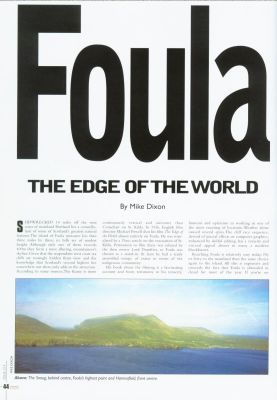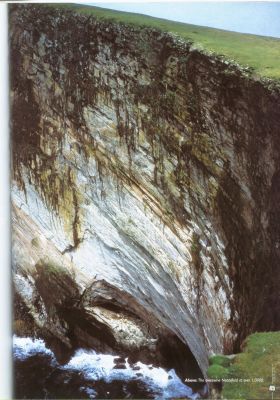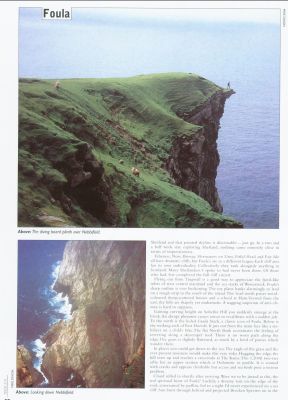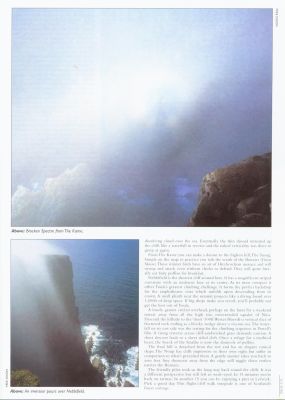Submitted by
John Holbourn
Foula
The Edge of the World
High Mountain Magazine: Issue 214, Sept 2000
By Mike Dixon
Shipwrecked 14 miles off the west coast of mainland Shetland lies a constellation of some of Scotland's greatest natural features. The island of Foula measures less than three miles by three; its hills are of modest height. Although only one of them exceeds 400m they form a most alluring, mountaineer's skyline. Given that the stupendous west coast sea cliffs are teasingly hidden from view and the knowledge that Scotland's second highest lies somewhere out there, only adds to the attraction. According to some sources, The Kame is more continuously vertical and awesome than Conachair on St. Kilda. In 1936, English Film director Michael Powell shot his film The Edge of the World almost entirely on Foula. He was stimulated by a Times article on the evacuation of St. Kilda. Permission to film there was refused by the then owner Lord Dumfries, so Foula was chosen as a stand-in. At least he had a ready assembled troupe of extras in terms of the indigenous community.
His book about the filming is a fascinating account and bears testimony to his tenacity, humour and optimism in working in one of the most exacting of locations. Weather alone caused several epics. The cliff race sequence, devoid of special effects or computer graphics, enhanced by skilful editing, has a veracity and visceral appeal absent in many a modern blockbuster.
Reaching Foula is relatively easy today. Fly or ferry to the mainland then the same choice again to the island. All this is expensive and conceals the fact that Foula is shrouded in cloud for most of the year. If you're on Shetland and that pointed skyline is discernable... just go. In a two and a half week stay exploring Shetland, nothing came remotely close in terms of impressiveness.
Eshaness, Noss, Bressay, Hermaness on Unst, Fitful Head and Fair Isle all have dramatic cliffs, but Foula's are in a different league. Each cliff area has its own individuality. Collectively they rank alongside anything in Scotland. Many Shetlanders I spoke to had never been there. Of those that had, few completed the full cliff circuit.
Flying out from Tingwall is a good way to appreciate the fjord-like inlets of west central mainland and the sea stacks of Westerwick. Foula's sharp outline is ever beckoning. The toy plane banks alarmingly to land on a rough strip in the south of the island. The road north passes weird-coloured sheep, scattered houses and a school at Ham. Viewed from the east, the hills are shapely yet undramatic. A nagging suspicion of anti-climax is hard to suppress.
Gaining curving height on Soberlie Hill you suddenly emerge at the brink. An abrupt plummet causes senses to recalibrate with a sudden jolt. To the north is the holed Gaada Stack, a classic icon of Foula. Below is the striking arch of East Hoevdi. It juts out from the main face like a stabilizer on a child's bike. The flat North Bank accentuates the feeling of teetering along a skyscraper roof. There is no worn path along the edge. The grass is slightly flattened, as much by a herd of ponies which wander there.
In places you could get down to the sea. The angle of the grass and the ever present moisture would make this very risky. Hugging the edge, the hill rears up and reaches a crescendo at the Kame. This 1,200ft two-tier arlte has an upper section which is Dolomitic in profile. It is seamed with cracks and appears climbable but access and sea birds pose a serious problem.
Cloud rolled in shortly after arriving. Were we to be jinxed at this, the real spiritual heart of Foula? Luckily, a dreamy wait on the edge of the void, entertained by puffins, led to a sight I'd never seen on a sea cliff. Sun burst through behind and projected Brocken Spectres on to the dissolving cloud over the sea. Eventually the thin shroud retreated up the cliffs like a waterfall in reverse and the naked verticality was there to gawp at again.
From the Kame you can make a detour to the highest hill, The Sneug. Simple on the map; in practice you risk the wrath of the Bonxies (Great Skuas). These sinister birds have an air of Hitchcockian menace and will swoop and attack even without chicks to defend. They will quite literally eat baby puffins for breakfast.
Nebbifeld is the sheerest cliff around here. It has a magnificent striped curvature with an undercut base at its centre. At its most compact it offers Foula's greatest climbing challenge. It forms the perfect backdrop for the amphitheatre vista which unfolds upon descending from its crown. A small plinth near the summit projects like a diving board over 1,000ft of deep space. If big drops make you recoil, you'll probably not get the best out of Foula.
A lonely gannet circled overhead, perhaps on a hunt for a weekend retreat away from all the high rise, overcrowded squalor of Noss. Descend the hillside to the 'short' 500ft Wester Hoevdi - a vertical slice of fractured rock ending as a blocky wedge above a viscous sea. The waterfall on its east side was the setting for the climbing sequence in Powell's film. A rising traverse across cliff-sandwiched grass demands caution. A short descent leads to a sheer sided cleft. Once a refuge for a mythical beast, the Sneck of the Smallie is now the domicile of Puffins.
The final hill is detached from the rest and has an elegant conical shape. The Noup has cliffs impressive in their own right but suffer in comparison to what's preceded them. A gentle saunter takes you back to zero feet. Any shortcuts away from the edge will niggle those restless natives the Bonxies.
The friendly pilot took us the long way back around the cliffs. It was a different perspective but still left us wide-eyed. In 15 minutes you're back on tarmac. In another 15 you can be enjoying a pint in Lerwick. Pick a good day. This flight/cliff walk integrale is one of Scotland's finest outings.
200,000 Feet on Foula
By: Michael Powell
London: Faber & Faber, 1938.
US Title "200,000 Feet - The Edge of the World"
New York: E.P. Dutton & co., 1938.
London & Boston: Faber & Faber, 1990 (paperback).
The story of the cast & crew's stay on the island whilst making the film
The title is a reference to the amount of film used,
not the height of the cliffs
|
The article includes some stunning pictures
|

The Sneug, behind centre, Foula's highest point
and Hammafield, front centre.
|

The awesome Nebbifield
at over 1,000ft.
|
|
|

Top: The Diving Board plinth over Nebbifield.
Bottom: Looking down Nebbifield.
|

Top: Brocken Spectre, from The Kane.
Bottom: An inversion pours over Nebbifield.
|
Back to index





